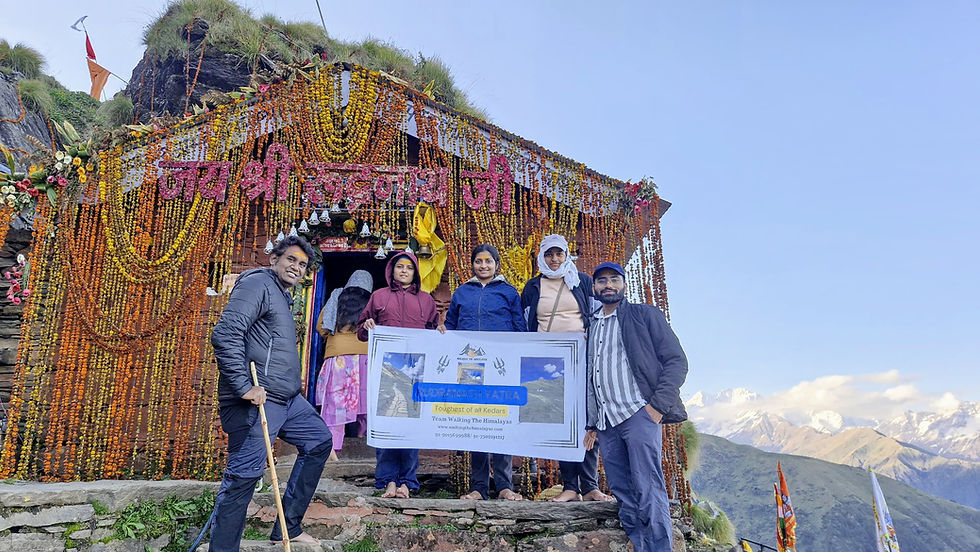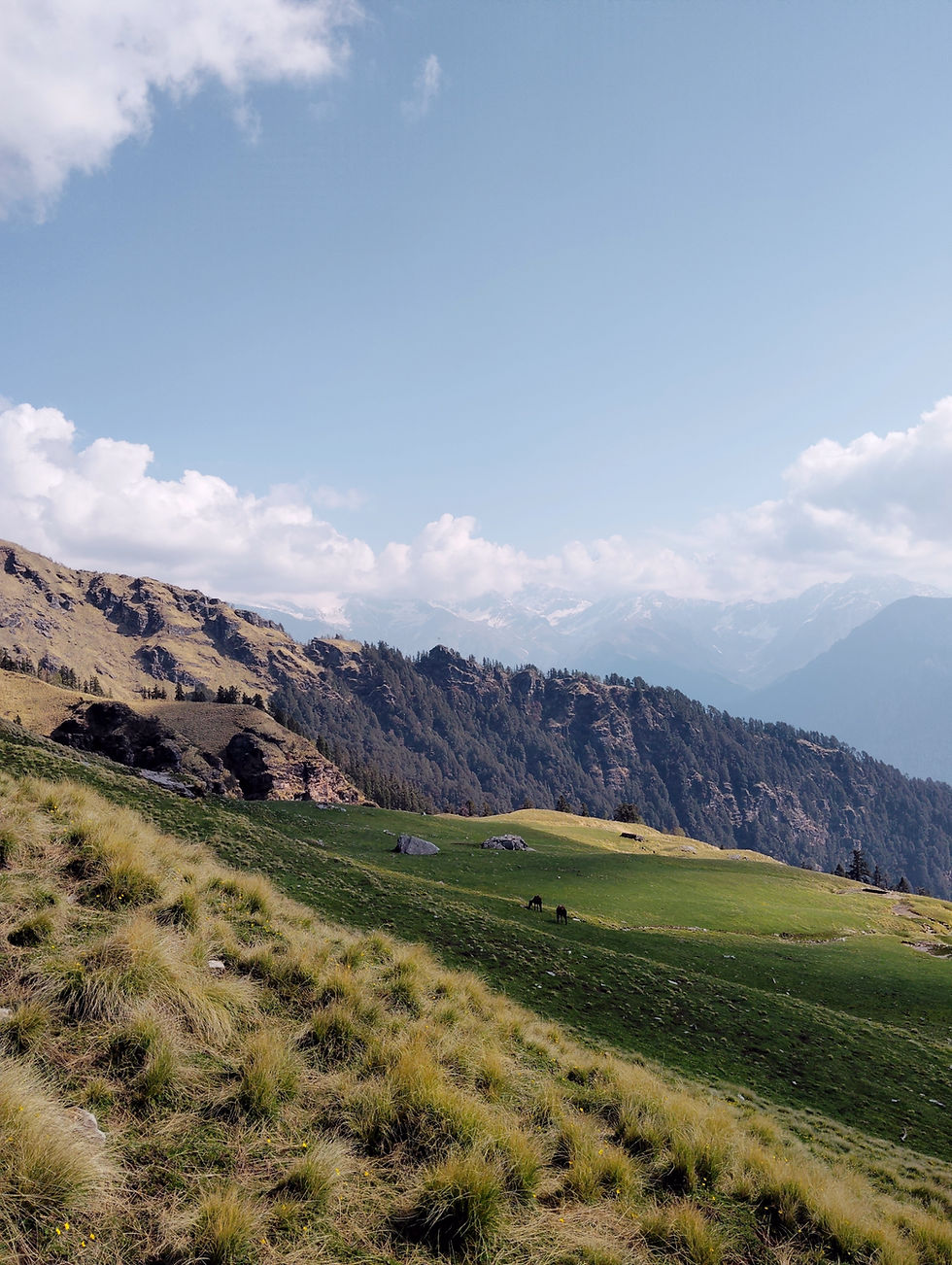Rudranath: A Journey to the Hidden Face of Lord Shiva
- Team Walking The Himalayas

- Jul 15, 2025
- 7 min read
Nestled deep in the Garhwal Himalayas of Uttarakhand, the Rudranath Temple is one of the Panch Kedar shrines and a sacred destination for Lord Shiva devotees and adventure seekers alike. Far away from the hustle and bustle of city life, this serene and mystical place offers a divine blend of spirituality, natural beauty, and Himalayan wilderness.
Whether you're a seasoned trekker, a spiritual seeker, or someone just looking to escape into nature, the Rudranath Trek offers a once-in-a-lifetime experience. In this blog, we’ll cover everything you need to know—Rudranath trek distance, Rudranath location, Rudranath height, how to reach, best time to visit, Rudranath photos, cost of the trek, and more.

What Makes Rudranath Special?
Rudranath Temple is one of the five Panch Kedar shrines dedicated to Lord Shiva. According to Hindu mythology, after the Mahabharata war, the Pandavas sought forgiveness for killing their kin. Lord Shiva eluded them and took the form of a bull, disappearing into the ground. He later reappeared in five different locations in the Himalayas, which became the Panch Kedar—Kedarnath (hump), Tungnath (arms), Rudranath (face), Madhyamaheshwar (navel), and Kalpeshwar (hair).
Rudranath is the only temple where Lord Shiva's face (mukha) is worshipped. The natural rock temple surrounded by dense forests, alpine meadows, and majestic peaks like Nanda Devi and Trishul offers a surreal setting for spiritual contemplation and scenic joy.
Rudranath Location and How to Reach
Rudranath Location: Chamoli district, Garhwal region, Uttarakhand, India
Coordinates: 30.4941° N, 79.3233° E
Nearest Town: Gopeshwar
Base Village: Sagar or Mandal
To reach Rudranath, travelers usually go to Gopeshwar, which is well-connected by road from Rishikesh, Haridwar, and Dehradun. From Gopeshwar, one can drive to Sagar Village or Mandal Village, which are the starting points of the Rudranath trek.
Rudranath Height and Climate
Rudranath Height: 3,600 meters (11,800 feet) above sea level
Due to its high altitude, Rudranath has a cool and alpine climate. Summers (May to October) are ideal for trekking, while winters are harsh with heavy snowfall, making the temple inaccessible.

Rudranath Trek Distance and Route
The Rudranath trek distance depends on the route you choose:
Via Sagar Village:
Distance: ~20 km one way
Route: Sagar – Panar Bugyal – Pitradhar – Rudranath
Most popular and scenic trail
Via Mandal and Anusuya Devi Temple:
Distance: ~24 km
Route: Mandal – Anusuya Temple – Pitradhar – Rudranath
Spiritual and serene route
Alternative Long Route via Kalpeshwar:
Distance: 70+ km over multiple days
This is for those who want to cover the entire Panch Kedar circuit on foot.
The trek takes 1–2 days, depending on your fitness and acclimatization. The trail passes through thick rhododendron forests, vast alpine meadows like Panar Bugyal, and sacred shrines.
Rudranath Trek Cost
The Rudranath trek cost depends on whether you're doing it solo, with a guide, or through a trekking company:
Solo or DIY Trekking: ₹10000 - ₹15000 (includes transport, meals, and basic lodging)
With Local Guide: ₹8000 - ₹9,000 ( Sagar to Sagar)
With Trekking Agency: ₹12,000 to ₹15,000 (usually a 5 day package) Walking The Himalayas Rudranath Package is ₹130000
Cost includes transportation, accommodation (basic homestays or tents), meals, guide, porter (optional), and permits if applicable.
Rudranath Photos and Views
The visual beauty of the Rudranath trek is unmatched. From meadows blooming with Himalayan flowers to snowy peaks towering above, every frame is worth capturing. Some key highlights for Rudranath photos include:
Panar Bugyal: A stunning alpine meadow with panoramic Himalayan views.
Pitradhar Ridge: A sacred site believed to be the point where ancestors bless the travelers.
Rudranath Temple: The stone temple surrounded by flags and mist looks straight out of mythology.
Nanda Devi and Trishul Views: Watch these mighty peaks glow during sunrise and sunset.
Don’t forget to capture early morning Tungnath photos if you plan to do the Tungnath to Rudranath trek.
Rudranath Shivling and Temple Architecture
The Rudranath shivling is worshipped in the form of a natural rock formation resembling the face of Lord Shiva. The Rudranath temple is an ancient stone shrine, believed to be over 1,000 years old. Built amidst a dense forest, the temple houses the Mukha (face) of Shiva, and the spiritual energy of the place is deeply moving.

Nearby are other sacred sites like:
Surya Kund
Chandra Kund
Tara Kund
Saraswati Kund
These crystal-clear ponds reflect the surrounding beauty and are considered spiritually purifying.
Rudranath Yatra and Pilgrimage
The Rudranath Yatra typically starts in late May or early June when the snow melts. It continues until mid-October. A big local event called the Rudranath Mela is held in the Shravan month (July-August), attracting thousands of devotees.
During the yatra, the idol of Lord Shiva is brought from Gopeshwar to Rudranath with much fanfare. This sacred journey is part of the Panch Kedar pilgrimage, often combined with other shrines like Kalpeshwar and Madmaheshwar trek.
Tungnath to Rudranath Trek
For those aiming to do multiple Kedars in one trip, the Tungnath to Rudranath trek is a thrilling yet challenging option.
Distance: ~32–35 km
Route: Tungnath – Chandrashila – Rohini Bugyal – Panar – Rudranath
Takes 2–3 days of high-altitude trekking
You get the unique chance to cover Tungnath, the highest Shiva temple in the world, and Rudranath in one go. The journey is blessed with surreal landscapes and mythological significance. Don’t forget to take some Tungnath photos at sunrise from Chandrashila Peak—it’s a spiritual moment.
Kalpeshwar and Madmaheshwar Trek Add-on
To complete the Panch Kedar trail or deepen your Himalayan pilgrimage, you can extend your Rudranath trek to:
Kalpeshwar: The only Panch Kedar open year-round, where Shiva’s hair is worshipped.
Madmaheshwar trek: Located at an altitude of 3,289 meters, it's the place where Shiva’s navel appeared.
Both treks require time and stamina, but reward you with unmatched solitude and divine presence.
Best Time to Visit Rudranath
May to June: Best season with blooming flowers and clear skies
September to October: Post-monsoon greenery with fewer crowds
Avoid July-August: Due to heavy rains and landslides
November to April: Temple remains closed due to snow
The temple is relocated to Gopeshwar in winter for worship.

Accommodation and Food
There are no hotels near the Rudranath temple. However, basic guest houses, homestays, and tents are available in:
Sagar Village
Moli Kharak
Lyuti Bugyal
Rudranath village (basic dharamshala-style lodging)
Local food includes rice, dal, chapati, and vegetables. Carry energy bars and dry fruits for the trek.
Essential Tips for Rudranath Trek
Acclimatize well: It’s a high-altitude trek
Pack light but smart: Raincoat, trekking shoes, warm layers
Stay hydrated
Avoid alcohol and smoking
Respect local culture and environment
Check weather updates before starting the trek
Final Thoughts
The Rudranath trek is not just about reaching a destination—it's about the journey, the silence of the Himalayas, the whispers of pine forests, and the timeless chants echoing from ancient stones. It's one of those treks where the divine and natural blend seamlessly, leaving you transformed.
Whether you're chasing divine blessings, panoramic Himalayan views, or just solitude, Rudranath offers it all. So lace up your boots, charge your camera for those magical Rudranath photos, and start your journey toward the sacred face of Lord Shiva.
Rudranath Trek Itinerary – 5 Days
📅 Day 1: Rishikesh to Sagar Village (Drive – 250 km, 9–10 hours)
Route: Rishikesh – Devprayag – Rudraprayag – Karnaprayag – Gopeshwar – Mandal – Sagar
Distance: Approx. 250 km by road
Travel Time: 9–10 hours
Altitude: Rishikesh (372 m) to Sagar (1,900 m)
Stay: Overnight in a guesthouse/homestay at Sagar
Highlights:
Start early from Rishikesh by 5:00 AM.
Scenic drive along the Alaknanda River and confluences like Devprayag (where Bhagirathi and Alaknanda meet to form the Ganga).
Halt at Karnaprayag or Gopeshwar for meals.
Reach Sagar by late afternoon or evening.
Prepare for the trek the next day; check gear, fill water, and rest well.
🥾 Day 2: Sagar – Pung – Lyuti Bugyal (Trek – 7 km, 5–6 hours)
Trek Distance: Approx. 7 km
Trek Time: 5–6 hours
Altitude: Sagar (1,900 m) to Lyuti Bugyal (~2,900 m)
Stay: Campsite or forest hut at Lyuti Bugyal
Route:
Sagar → Pung (~2.5 km, forest trail)
Pung → Lyuti Bugyal (~4.5 km, gradual ascent)
Highlights:
Initial climb through dense forest filled with rhododendrons and oaks.
Pung is a small meadow and water point, ideal for a quick rest.
Trek continues uphill with views opening toward Chaukhamba range and Kedarnath peaks.
Reach Lyuti Bugyal – an alpine meadow surrounded by mist and serenity.
Camp under the stars and enjoy dinner in the wilderness.
🏔️ Day 3: Lyuti Bugyal – Panar Bugyal – Pitradhar – Rudranath Temple (Trek – 12 km, 7–8 hours)
Trek Distance: Approx. 12 km
Trek Time: 7–8 hours
Altitude: Lyuti Bugyal (2,900 m) to Rudranath (3,600 m)
Stay: Basic lodge or dharamshala near Rudranath temple
Route:
Lyuti Bugyal → Panar Bugyal → Dhalabni Maidan → Pitradhar → Panch Ganga → Rudranath
Highlights:
The trail today is long but immensely beautiful.
Cross Panar Bugyal, one of the most scenic alpine meadows on this trek. Perfect spot for panoramic photos.
Spot peaks like Nanda Devi, Trishul, and Hathi-Ghoda.
Continue via Dhalabni Maidan and ascend to Pitradhar (high ridge believed to be the crossing point of ancestors’ souls).
Descend slightly to Panch Ganga, a confluence of five sacred water streams.
Reach Rudranath Temple, dedicated to Lord Shiva’s face (mukha roop). The temple is built of stone and set in a dramatic landscape.
Attend evening aarti at the temple; it’s a spiritually intense experience.
⛺ Day 4: Rudranath to Sagar (Trek – 19 km, 8–9 hours)
Trek Distance: Approx. 19 km
Trek Time: 8–9 hours
Stay: Overnight at Sagar village in a homestay
Highlights:
Retrace your steps through Panch Ganga, Pitradhar, Panar Bugyal, and Lyuti Bugyal.
Long descent – take care of knees and avoid rushing.
Reach Sagar by late afternoon or early evening.
Rest and enjoy the last night in the mountains.
🚗 Day 5: Sagar to Rishikesh (Drive – 250 km, 9–10 hours)
Route: Sagar – Mandal – Gopeshwar – Rudraprayag – Devprayag – Rishikesh
Distance: Approx. 250 km
Travel Time: 9–10 hours
Highlights:
Start early from Sagar for a smooth return.
En route stops for local food and shopping.
Reach Rishikesh by evening, marking the end of the Rudranath Yatra.
🌄 Trek Summary
Day | Route | Mode | Distance | Duration | Altitude Gain |
1 | Rishikesh → Sagar | Drive | 250 km | 9–10 hrs | +1,500 m |
2 | Sagar → Lyuti Bugyal | Trek | 7 km | 5–6 hrs | +1,000 m |
3 | Lyuti Bugyal → Rudranath | Trek | 12 km | 7–8 hrs | +700 m |
4 | Rudranath → Sagar | Trek | 19 km | 8–9 hrs | -1,700 m |
5 | Sagar → Rishikesh | Drive | 250 km | 9–10 hrs | -1,500 m |
Keywords used: rudranath trek distance, rudranath location, rudranath photos, rudranath height, rudranath shivling, rudranath temple, rudranath trek cost, kalpeshwar, madmaheshwar trek, tungnath photos, rudranath trek.



Comments